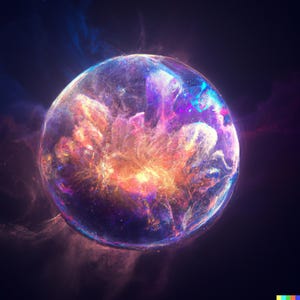
Astronomers Say This Neutron Star Explosion Was Perfect. Too Perfect - CNET
Astronomers Say This Neutron Star Explosion Was Perfect. Too Perfect
A strangely spherical explosion in space has astrophysicists scratching their heads.
No matter what, you do not want to find yourself near a neutron star.
These stellar beasts, made mostly of neutrons, are basically ultra-dense cosmic corpses roaming around space and, with incomprehensibly strong gravitational fields, torturing everything in their paths.
They’re like the baby brothers of black holes. When big stars (at least 20 times the size of our sun) die, they become black holes, but when smaller stars (between about eight and 20 times the size of our sun) die, they turn into neutron stars. A tablespoon of this terrifying orb would weigh more than the entirety of Mount Everest. You get the point.
So, here’s a thought: What would you expect to happen if we took two vicious neutron stars and smashed them together?
Well, I’d argue, anything except what scientists just observed.
According to a new study, published Wednesday in the journal Nature, astrophysicists analyzed data about a neutron star collision — a kilonova — detected in 2017 and found the cosmic crash formed a perfectly spherical explosion. That was unexpected.
“No one expected the explosion to look like this. It makes no sense that it is spherical, like a ball. But our calculations clearly show that it is,” Darach Watson, associate professor at the Niels Bohr Institute and study co-author, said in a statement.
Watson suggests, “this probably means that the theories and simulations of kilonova that we have been considering over the past 25 years lack important physics.”
Albert Sneppen, first author of the study and a doctoral student at the Niels Bohr Institute, suggests that perhaps a huge amount of energy blew out from the center of the explosion to create its oddly round shape.
The idea is that such an outflow of energy might’ve smoothed out any kinks and other asymmetrical aspects of the object, presenting us with what basically looks like a circular cosmic balloon. “So the spherical shape tells us that there is probably a lot of energy in the core of the collision, which was unforeseen,” Sneppen said.
Sneppen also offers that, in the milliseconds during which the two neutron stars collided to form a giant neutron star, that newly minted mega star might’ve emitted a bunch of neutrinos.
Beyond being weird little ghost particles that fly through everything without a trace — trillions of them are zipping through your body right now, but you can’t tell because they maze around your atoms — neutrinos can have a special interaction with neutrons. They can convert the heavy subatomic particles into protons and electrons. So, perhaps the neutron stars’ neutrons got converted?

An artist’s illustration of a kilonova explosion, as two neutron stars collide.
Robin Dienel/Carnegie Institution for Science)
This concept is especially interesting because it would explain how lighter elements could’ve formed with the kilonova as the team recorded.
“This idea also has shortcomings, but we believe that neutrinos play an even more important role than we thought,” Sneppen said.
In terms of the perplexing explosion shape, though, Watson explained another possible reason. Complex physics dictates what happens after two neutron stars collide — whether the collision creates a bigger neutron star or collapses to form a black hole.
“Perhaps,” Sneppen postulated, “a kind of ‘magnetic bomb’ is created at the moment when the energy from the hypermassive neutron star’s enormous magnetic field is released when the star collapses into a black hole. The release of magnetic energy could cause the matter in the explosion to be distributed more spherically. In that case, the birth of the black hole may be very energetic.”
Time is the only remedy for such puzzling cosmic mysteries.
Star-tographers
On an unrelated matter, however, the duo also point out that if all kilonovas across the universe actually are this bright, brilliant and spherical, they may serve another purpose: stellar cartography.
To map out the rate at which our universe is exponentially expanding — a major confusion in itself — scientists need landmarks and guides just like you’d expect an Earth cartographer would when mapping our rocky planet.
Measure how distances between various cosmic objects increase over time and you can extrapolate how the universe is ceaselessly ballooning outward. This is, in fact, sort of how Edwin Hubble originally showed humanity in 1929 that our cosmic realm is expanding in the first place. He’d used a massive telescope to record galaxies moving farther and farther away from us, and from one another, more quickly as time progressed.
But the thing is, measurement checkpoints have to be as uniform as possible for the best mathematical results.
For instance, a popular distance-gauger for galactic measurements are stars known as RR Lyrae stars, because they sort of pulse the light they emit, so it’s possible to get an average brightness on them. Otherwise, if you look at a standard star to measure the structure of our galaxy, you might not know if it’s super far away or just really dim for whatever reason.
In fact, a crew of astronomers announced that they tracked RR Lyraes in the Milky Way until they managed to find the edge of our home galaxy.
When it comes to shape, though, neutron star collisions seem to be key.
“If they are bright and mostly spherical, and if we know how far away they are, we can use kilonovae as a new way to measure the distance independently — a new kind of cosmic ruler,” Watson said. “Knowing what the shape is, is crucial here, because if you have an object that is not spherical, it emits differently, depending on your sight angle. A spherical explosion [provides] much greater precision in the measurement.”

